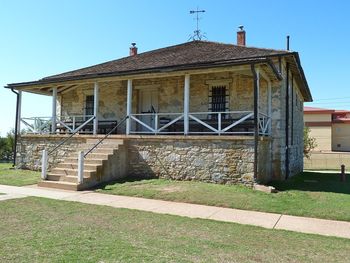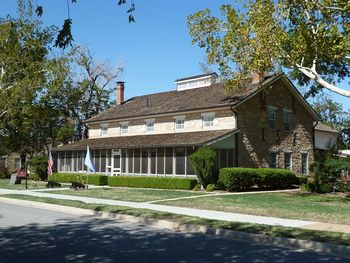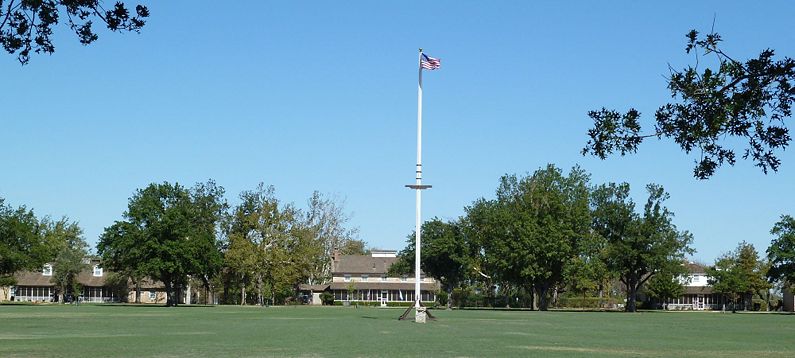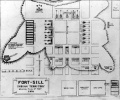Fort Sill (1)
|
Fort Sill (1) (1869-Active) - Staked out 8 Jan 1869 by Major General Philip H. Sheridan. Initially named Camp Wichita but renamed Camp Sill, Jul 1869, by Sheridan after his West Point classmate, Brigadier General Joshua W. Sill who was killed in the U.S. Civil War leading the charge of Sheridan’s Brigade during the Battle on Stone River in Tennessee on 31 Dec 1862. The first post commander was Bvt. Major General Benjamin Grierson who initially selected the site along with Colonel William B. Hazen. The fort was established to stop hostile Indian tribes from raiding border settlements in Texas and Kansas.
HistoryThe fort was initially manned by six cavalry regiments accompanied by frontier scouts such as Buffalo Bill Cody, Wild Bill Hickok, Ben Clark and Jack Stilwell. Units posted included the 7th U.S. Cavalry, the 19th Kansas Volunteers and the 10th U.S. Cavalry. The 10th U.S. Cavalry was organized by Colonel Grierson after the U.S. Civil War and consisted of white officers and black "buffalo soldiers". The 10th U.S. Cavalry constructed many of the stone buildings that still surrounding the old post quadrangle. PeaceIn 1869 President Grant approved a peace policy placing responsibility for the Southwest tribes under Quaker Indian agents. Fort Sill soldiers were restricted from taking punitive action against the Indians. The Indians resumed raiding the Texas frontier and used Fort Sill as a sanctuary. In 1871 General of the Army William Tecumseh Sherman arrived at Fort Sill to find several Kiowa chiefs boasting about a wagon train massacre. When Sherman ordered their arrest during a meeting on Grierson's porch two of the Indians attempted to assassinate him. On 2 Jun 1875, Comanche Chief Quannah Parker arrived at Fort Sill, accompanied by most of the Quohadas tribe. There were 100 warriors, 300 non-combatants, and 1400 ponies. The men were disarmed and the pony herd was auctioned off. This marked the last of the Indian hostilities. Geronimo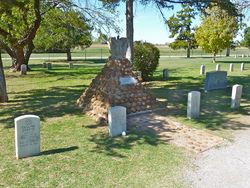 In 1894 Geronimo and 341 other Apache prisoners of war were brought to Fort Sill where they lived in villages on the range. Geronimo died at Fort Sill of pneumonia in 1909 and is buried there. The rest of the Apaches remained on Fort Sill until 1913 and they were taught by Lt. Hugh L. Scott to build houses, raise crops and herd cattle. Scott also commanded troop L of the 7th U.S. Cavalry, a unit comprised entirely of Indians and considered one of the best in the west. Indian scout I-See-O and other members of the troop are credited with helping tribes on the South Plains to Avert the Bloody Ghost Dance uprising of the 1890s in which many died on the North Plains.
Oklahoma Land RushThe Last Indian lands in Oklahoma opened for settlement in 1901 and 29,000 homesteaders registered at Fort Sill during July 1901 for the land lottery also known as the "Oklahoma Land Rush". The mission of Fort Sill gradually changed from cavalry to field artillery with the first artillery battery arriving in 1902 and the last cavalry regiment departing in May 1907. 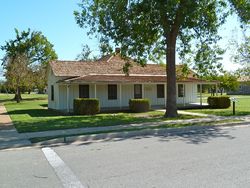 The School of Fire for the Field Artillery. was founded at Fort Sill in 1911 and continues to operate today as the world renowned U.S. Army Field Artillery School. At various times Fort Sill has also served as home to the Infantry school of Musketry, the School for Aerial Observers, the Air Service Flying School, and the Army Aviation School.
Current Status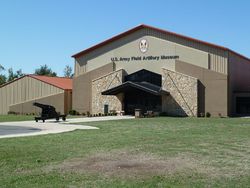 Fort Sill remains the only active Army installation of all the forts on the South Plains built during the Indian wars. It serves as a national historic landmark and home of the Field Artillery.
Source:
Links:
Visited: 18 Oct 2011 Picture Gallery
| ||||||||||||||||||||||||||||||||||||||||||||||||||||||||||||||||||||||||||||||||||||||||||||||||
